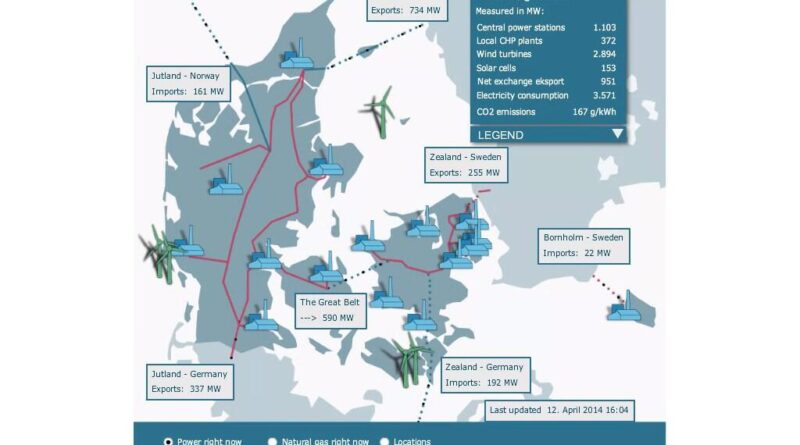Watching Wind Energy At Work In Denmark
Originally published on the ECOreport.

I have finally seen a wind energy project that works and of course it would be in Denmark!
My apologies, in advance, to all the people who are going to protest.
I find Jim Wiegand’s research, on how wind turbines are wreaking far more raptor casualties than is being acknowledged, conclusive.
The manner in which wind farms are being forced upon the residents of East County and Ocotillo, in California, is morally offensive.
Furthermore, the Ocotillo Wind Farm does not really work! Jim Pelley has been documenting the lack of wind since the project went online. Though his report has not arrived yet this morning, I suspect it will be yet another video of wind turbines that are not moving and wind speeds of somewhere between 0 and 4 mph. You can see hundreds of his videos – 373 at last count – at the youtube site Save Ocotillo: https://www.youtube.com/user/SaveOcotillo
I have heard a few stories about wind farms that work and far more about those that do not. So much, in fact, that I have come to question whether this technology even works.
It does. Let me direct you to the website: http://energinet.dk/Flash/Forside/UK/index.html It is an live online register of Denmark’s power.
Note the figures for energy being produced by wind turbines (3407 MW) and electricity consumption (3,608 MW) in the graph to the left . At the moment the wind turbines are producing a little more than 94% of the energy being used. When I first saw this site, last night, the turbines were producing between 96 and 97%. Earlier this morning, it was close to 100%.
Googling the site, I came across a report from last fall that shows the Danes frequently produce +90% of their energy demand.
As I am typing this, the wind picked up and those turbines are now producing 99.7% of the energy Denmark needs.
 I love the simplicity of this system! Rather than waste our time with the hypothetical capacity that turbines seldom reach, the Danes show you how much is being produced and consumed at any given moment.
I love the simplicity of this system! Rather than waste our time with the hypothetical capacity that turbines seldom reach, the Danes show you how much is being produced and consumed at any given moment.
The graph at the top of this page is much more complex because Denmark imports a fixed amount of energy from Germany and exports surplus energy to Norway and Sweden.
In addition to wind turbines, the Danes have central power stations and local CHP stations.
They are always exporting more energy than they import, which is why the graph says “net exchange eksport.”
At the moment they are exporting 813 MW. The wind has picked up a little and if consumption had not increased even more, they would now be at +100%. Instead, they are meeting 93.38% of the amount domestically consumed.

I have heard of wind farms that work, but seeing really is believing.
I do not know how long these turbines will continue to produce this amount of energy, but Denmark did not derive 55% of its energy over the course of a month prior to December.
According to Energy statistics 2012, 33% of Denmark’s electricity was derived from renewables in 2012. Production of crude oil and natural gas dropped 8.8% and 11.9% respectively, and renewables went up 5.4%. This contributed to the drop of “observed CO2 emissions from energy consumption,” which fell by 10.3% to 39.9 million tonnes.
It would appear that in Denmark, wind energy does supply a viable energy source — but that does not eradicate the problems.
We should not be eradicating raptors. If the wind sector cannot deal with this problem, we should be looking at alternative technologies like solar.
North Americans should not be building wind farms in areas where they are not economically feasible. When Patrick Jenevein got out of the wind business, he said the industry was being driven by politics rather than economic:
Wind energy will make marginal—not revolutionary—contributions. The industry’s success in Texas (where my company is based, and which is the nation’s largest and cheapest producer of wind power) suggests that wind farms do make sense in relatively windy areas where electricity shortages occur. But policy matters. California, which isn’t located in the ‘wind belt,’ is America’s second-largest wind-energy producer but also its costliest. The state’s high costs are partly due to aggressive renewable energy policies . . . that give developers a strong negotiating position…
Jenevein believes that US government subsidies should be eliminated so that the industry will focus “less on working the political system and more on research and development.”
I have no interest in perpetuating a system that creates, and then refuses to acknowledge, a fiasco like the Ocotillo Wind Farm.
All of that said, it appears that wind technology works when it is used properly.
Image at top of page: screenshot from http://energinet.dk/Flash/Forside/UK/index.html
Have a tip for CleanTechnica? Want to advertise? Want to suggest a guest for our CleanTech Talk podcast? Contact us here.
Latest CleanTechnica.TV Video

CleanTechnica uses affiliate links. See our policy here.


